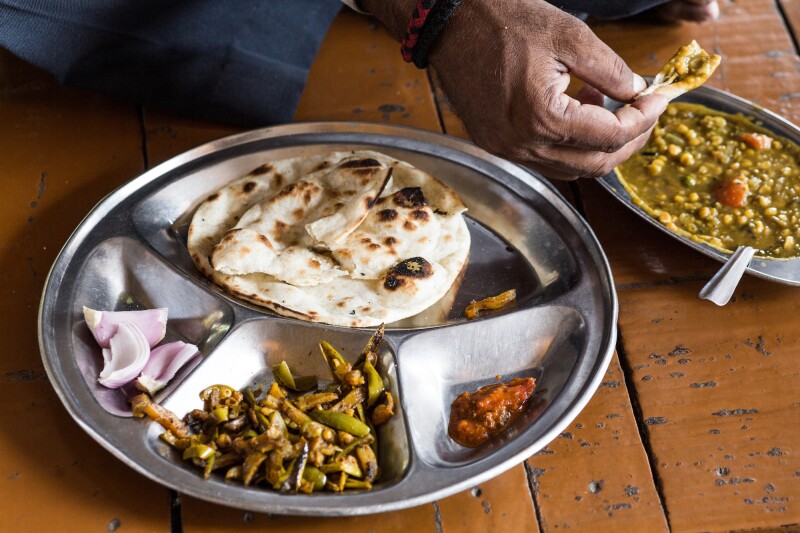We are all born with a remarkable set of eating utensils. They are versatile, impossible to misplace, and relatively unbreakable. Millions of diners around the globe swear that neither slender sticks nor pointy metal objects are better designed to ferry food to our faces than our hands. If you’ve eaten pizza, a burger, or fries, you’ve already had a taste of eating with your hands. But if you’re headed to one of many countries around the world where it’s habit, now is the perfect time to expand your repertoire of techniques and dishes.
The perks of the practice
It’s not just the ease of always having a set of nature’s cutlery within reach that makes eating with one’s hands appealing. Across India, much of Africa, and Southeast Asia, those who ditch the fork wax rhapsodic about the sensuous connection they feel to their meals and the intimacy that comes from sharing food with fellow diners. Many even argue that a metal utensil interferes with the flavors of signature dishes from some of these treasured cuisines.
Other advantages of eating by hand include preventing burned lips and avoiding food waste (dexterous fingers are better than forks at plucking every last shred of meat off the bones). Savoring smaller bites fashioned by hand also encourages a slower, more mindful pace, which leads to better digestion. Finally, you’ll always know your utensils are clean before you sit down to your meal—after all, you’re the one washing them.
What to expect when you grab a bite
In countries where this style of eating is common, the cuisine often incorporates an intermediary starchy staple that assists in the transfer of meat or vegetables from plate to mouth. Torn pieces of bread act as mini-scoops or a mound of rice serves as a base for a bite.
In many African countries, such as Ghana and Nigeria, a pinched hunk of fufu (a starchy dough usually made from cassava and plantain) is dipped into soups or stews.
Morocco’s sweet and savory tagines, such as lamb with prune, are served on communal trays and eaten with ripped pieces of round flatbread.

Curry and chapati in India
Photo by Studio-Neosiam/Shutterstock
In Northern India, where roti and naan are consumed, a torn piece of flatbread can help pluck a pinch of spiced cauliflower and green peas from gobi matar masala, for example. In South India, rice is combined with various curries and each diner can mix up a unique bite to match their preferences.
In the Filipino kamayan feast, a table is lined with banana leaves, then topped by a mound of rice and an array of dishes such as lumpia, grilled pork, a whole tilapia, salted eggs, and purple yams, to name a few. Diners pick up some rice, form it into a ball, then choose a piece of meat or fish and push the two pieces together into a bite. The word “kamayan” comes from the Tagalog kamay, which means hands.
Diners in Arab countries such as Lebanon, Saudi Arabia, and Yemen rip off a piece of pita bread and fold it into a little spoon to scoop up mezze such as hummus and baba ganoush. But it’s a one-use-only spoon so you need to devour it with the food it carried and take a new one for the next bite.
In Ethiopia’s 3,000-year-old cuisine, injera, a spongy, crepe-like bread made from teff, serves as both plate and utensil. After tearing off a small square of injera, a diner will lay it over several dishes on the tray, such as collard greens with black cumin, or split peas in turmeric sauce. Then, using all the fingers, that person will gather up the filling and twist it into a little packed pouch.
In Ethiopian culture, and in many others too, the practice of eating with the hands is more than just a way of getting sustenance into the mouth. One can also demonstrate caring by making bites for fellow diners, like an honored guest, or a child who is not eating enough. This loving act is called gursha.
A handy set of rules When it comes to eating practices, many Muslims follow the example of the Prophet Mohammed, who taught that one should eat slowly from one’s own side of the dish until hunger is just sated and that one should also share food with others. But the most important rule of all is to eat only with the right hand.
Actually, all cultures that eat with the hands agree that only the right hand should be employed for eating. The left hand is considered unclean because, at least in principle, it is used for personal hygiene.
The second rule that extends to all who shun silverware is to wash the hands before and after meals. Depending on where you are, this can be accomplished with finger bowls on the table, a dedicated sink, or an elaborate ritual of pouring of water over the hands from a brass pitcher into bowl.
Here are a few other rules you should keep in mind:
- Count your fingers. In several cultures, using three fingers, not five, is most polite.
- Take food nearest you on the serving dish.
- Don’t double dip.
- When appropriate, use bread or rice to anchor your bite.
- Take a modest bite in your fingers that will fit in your mouth without stuffing.
- Lightly deposit food in the mouth, without sticking fingers all the way in. Use your thumb to help push the food in.
- When appropriate, construct a bite for your companion.
- After a meal, licking your fingers before washing your hands is optional.
If you still feel a bit hesitant about this unfamiliar way of eating, remember the words of India’s first prime minister, Jawaharlal Nehru, “Eating with a fork and knife is like making love through an interpreter.”
>>Next: Tips From a Sign Language Interpreter for Overcoming Language Barriers








